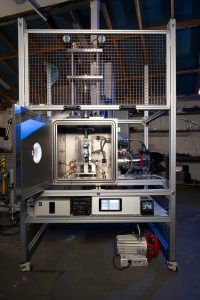Known as the NextSpace Testrig, this pioneering platform is designed to ensure that components manufactured in space are structurally sound and safe – marking a major advancement in the rapidly evolving field of space manufacturing.
As space agencies and private companies shift towards building infrastructure directly in orbit, the ability to rigorously test and validate 3D-printed materials under true-to-space conditions has never been more critical.
The NextSpace Testrig brings this capability to Earth for the first time, creating a vital bridge between innovation and real-world application.
With £253,000 in support from the UK Space Agency’s Enabling Technology Programme, the project is led by Dr Gilles Bailet in collaboration with The Manufacturing Technology Centre.
Dr Bailet highlighted the significance of the project: “3D printing is a very promising technology for allowing us to build very complex structures directly in orbit instead of taking them into space on rockets.
“It could enable us to create a wide variety of devices, from lightweight communications antennas to solar reflectors to structural parts of spacecraft or even human habitats for missions to the Moon and beyond.”
Why space manufacturing matters
Traditional space missions rely on launching fully assembled equipment into orbit, which is both costly and constrained by rocket size limits.
Space manufacturing offers a radically different approach: use specialised 3D printers to build complex components such as solar reflectors, antennas, and even spacecraft parts directly in orbit.
This method promises substantial savings and logistical advantages. It could enable future missions to assemble structures on the Moon or Mars without the need to haul them from Earth.
Astronauts aboard the International Space Station (ISS) have already demonstrated the feasibility of printing small metal parts in microgravity. However, questions remain about the durability and safety of these components over time.
Tackling the risk of space junk
One of the most pressing challenges of in-space 3D printing is the risk of structural failure. Even minor imperfections like tiny air bubbles or poorly fused layers can cause parts to fail catastrophically under orbital conditions.
In space, a small fragment from a disintegrated component can travel at speeds comparable to a rifle bullet, posing a serious threat to satellites, space stations, and other spacecraft.
This threat contributes to the mounting problem of orbital debris, also known as space junk. The NextSpace Testrig aims to be a key tool in mitigating this danger by providing reliable, real-world data on how 3D-printed materials behave in space-like environments.
This data will be invaluable for both manufacturers and regulators as they develop safety standards for in-orbit construction.
Recreating space on Earth
At the core of the facility is a custom-built vacuum chamber capable of simulating the brutal environment of space.
Temperatures within the chamber can swing from -150°C to +250°C, accurately replicating the thermal extremes that orbiting materials must endure.
This high-fidelity simulation allows researchers to study how 3D-printed polymers, ceramics, and metals hold up when exposed to intense physical stress.
A unique magazine system further sets the NextSpace Testrig apart, enabling automated testing of multiple samples in a single cycle.
These samples can be subjected to up to 20 kilonewtons of force – equivalent to 2,000 kilogrammes – while being monitored for signs of failure, deformation, or structural weakness.
Positioning the UK as a space manufacturing leader
The NextSpace Testrig represents a strategic investment in the UK’s growing space sector. Glasgow is already a prominent hub for satellite manufacturing, producing more satellites than any city in the world outside of California.
The addition of this cutting-edge testing technology solidifies the city’s status as a global leader in space technology.
Dr Bailet has also developed a prototype 3D printer designed specifically for orbital use, which has undergone trials aboard parabolic research flights, commonly known as the “vomit comet.”
These innovations could pave the way for future missions where spacecraft are assembled and maintained in orbit, reducing reliance on expensive Earth-based launches.
The NextSpace Testrig is now open to academic researchers and commercial partners worldwide, offering a unique capability that currently exists nowhere else.
By pushing the boundaries of what’s possible in space manufacturing, this Glasgow-based initiative is not only supporting scientific discovery but also ensuring that our ambitions in orbit don’t come at the cost of safety or the future of the space environment.



